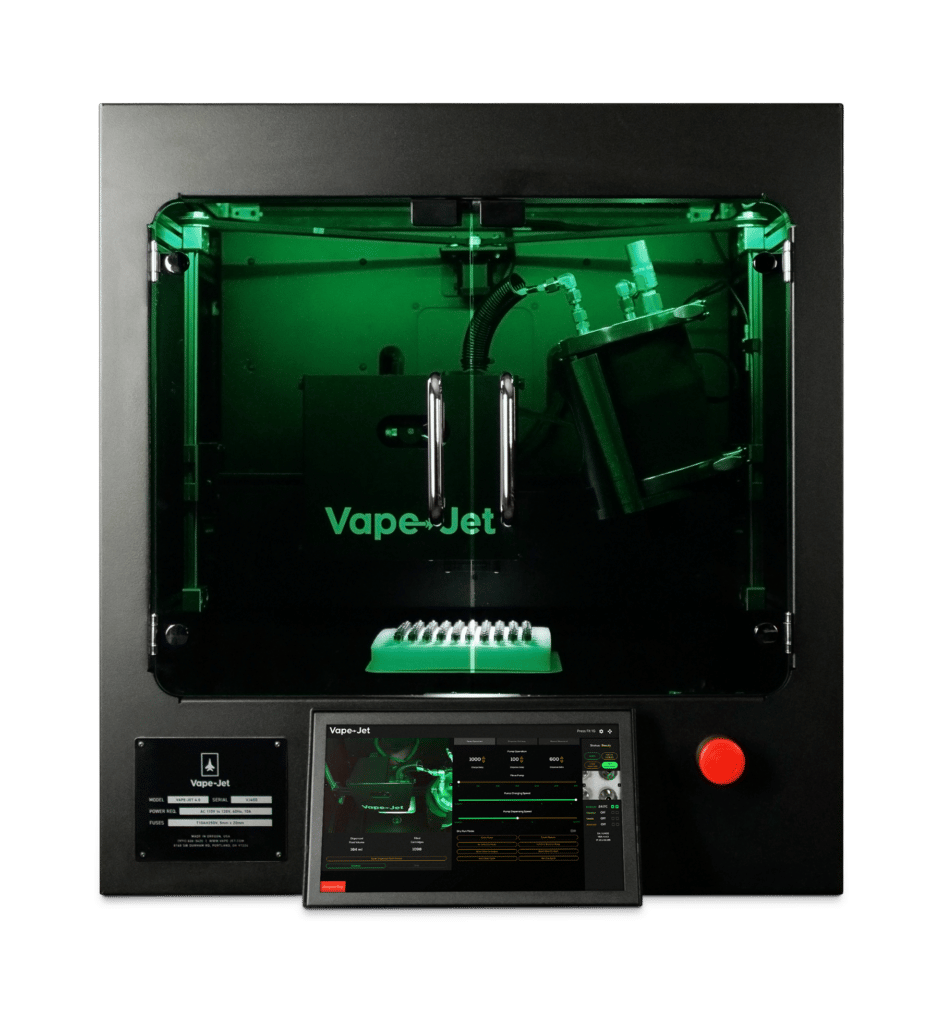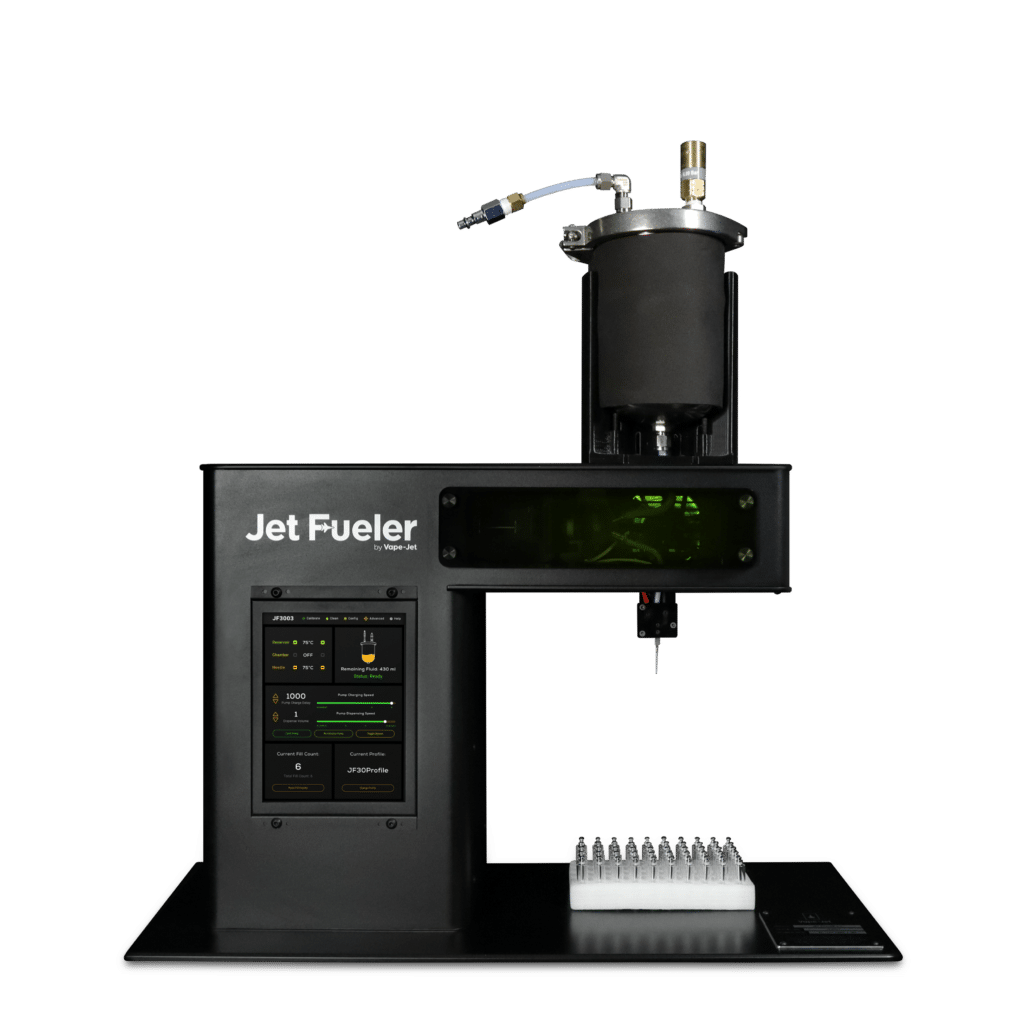Vaping has been around for longer than you think, and its use case has morphed drastically from decreasing nicotine consumption to indulging in cannabis products. As the hysteria caused by the lack of facts and misinformation from the recent EVALI crisis subsides – vape cartridges are slated for increased demand as the cannabis industry continues to rev its powerful engine.

There’s no better time than now to incorporate industry-leading automated concentrate cartridge filling technology to reap the benefits of tomorrow.
Before making your mark on the future of vaping, it’s important to learn about its past. So, here, we’ll catch you up on the history of cannabis vaping, including the answer to the question, when were weed carts invented? and when they were improved upon, too.
Read along to learn more and understand how to scale up your vape cartridge production process to effectively reduce overhead and increase revenue while improving consumer safety and quality control.
The History Of Vape Pens and Who Invented Them
Joseph Robinson created the first electronic vapes in the 1930s, long before there were vape carts as we know them today. Although it’s unknown whether he created a prototype, he is credited as the first person to come up with the idea.
From that point onward, many iterations of vaping devices came and went. However, it wasn’t until the early 2000s that vaping became a commercial success, thanks to the invention of the vape cartridge. However, all of these products were geared towards nicotine consumption in the form of e-cigarettes, neglecting the burgeoning market for cannabis oil and THC oil [1]
As we fast-forward through time, vaping became a rapidly rising trend as of 2011, with over 7 million users. It’s since ballooned to over 41 million users as of 2018. [2]
It’s likely that the dramatic rise in use is the culmination of new and more reliable vape products and the convenience of the vape cartridge as a consumption device. Vape devices are unmatched in consumer preference when it comes to form-factor and ease of use.
Modern-Day Inventions of Cannabis Vaping Devices
Currently, oil cartridges can be filled with any type, whether it’s THC, CBD, or nicotine-based. These extracts should be produced according to regulations that demand safe production practices and ingredients. However, taking short cuts during the product formulation stage can have disastrous consequences, as the recent EVALI crisis demonstrated.
Aside from the vape oil itself, vaping hardware and filling techniques are the most widely scrutinized aspects of vape cartridges. The reason behind this is the prevalence of the black market, which continues to distribute faulty and ill-equipped vaping cartridges, or utilize filling processes that expose the oil to toxic materials. Poor handling techniques during the filling process can lead to product contamination, illness, and, in severe cases, injury and death.
The vaping scandal of 2019 was the result of the black market selling tainted THC cartridges, which are widely believed to be the compound vitamin E acetate, a significant health risk when inhaled. Vitamin E was used to ‘cut’ the THC distillate, reducing the potency and reducing production costs. [3]
Since the EVALI crisis, the FDA and federal regulators have tightened their grip on the vaping industry, which means everything if your business incorporates or produces vape products.
Vaporizers and the Cannabis Community: A Growing Demand Despite Hesitations
According to Grand View Research, a leading market analysis group, the vape industry will reach over $67 billion by 2027.

While the EVALI health crisis caused a public perception hit to the perceived safety of the vape cartridge, it is a good idea to remember why consumers chose them in the first place. Even though personal vaporizer devices for nicotine consumption list health and safety as their primary motivating factors in purchasing decisions, those consumers consuming cannabis and hemp-derived products overwhelmingly select them for convenience and form factor, not perceived health effects.
In fact, companies in the cannabis vape tech space, like KandyPens and Dr. Dabber, recorded between 350 and 500 percent growth in 2017. [6] Even more, former Apple product developers and Silicon Valley types are credited with launching some of the highest-tech and most successful vape devices on the cannabis market today. [7]
As consumer confidence rebounds and proper QA techniques are adopted, the potential is sky-high for your vape-based businesses.
What Is A 510 Thread Cartridge?
If you’re now wondering, when did cannabis carts become popular? It’s around the time 510 thread cartridges launched in legal markets. So, for the industry newbies, next let’s answer the question: What is a 510 thread cartridge exactly?
A 510-threaded cartridge is a universal vapor product that’s filled with cannabis oil. When attached to a vape battery, and powered on or activated by draw, the oil is heated and inhaled by the consumer.
In today’s world of weed, 510 thread cartridges are available in .5 gram and 1 gram and are viable vestibules for a wide variety of extract types from distillate, to live resin and rosin.
The Future of the Vape Market & What Does This Mean for Your Business?
With increased regulations and rapidly rising demand, your vape business is looking towards a crossroads. How will you incorporate heightened quality control checks while managing the pressure of increasing demand?
The answer lies in consolidation and scalability. However, the idea of revamping your entire production process may sound daunting and, quite frankly, difficult to incorporate.
However, consolidation and scalability are accomplished with the help of automation. Automation can take many forms, but typically, when we think of automation, we think of production and manufacturing devices such as the Vape Jet automatic distillate cartridge filling machine.
The process of filling and checking the quality of cartridges is incredibly time-consuming when done manually. However, automated systems, such as the Vape-Jet, incorporate a pharmaceutical-grade fluid handling system and advanced machine vision alignment capabilities.

With the use of an automated vape cartridge filler, multiple tasks are accomplished effectively and up to regulatory standards. By using a cartridge filler for CO2, rosin, or distillate, your business can quickly consolidate resources and scale according to the demands of the market.
No longer will your business suffer from the love-hate relationship of increased demand. Instead, an industrial vape pod filler will streamline the production process while simultaneously ensuring quality control and the integrity of vapor products.
The Future of Cannabis: Reduce Your Cartridge Production Overhead Through Automation
If you have yet to incorporate automation into your vape business, you’re likely paying more than you have to. Without automation, your payroll is dedicated to individuals who are hard-capped as to the number of vape pods they can fill per day.
Automation opens the horizon to thousands of carts filled per day in comparison. This means that you’ll never miss out on a large order because you aren’t producing at scale. Instead, your clients will never lose confidence in your company’s ability to generate any amount of vape cartridges at any time, ensuring a consistent supply for consumers looking to vaporize.
The result of producing products at scale is that you’ll never miss a profitable opportunity. Furthermore, your overhead will plummet as you incorporate automation into your oil cartridge filling process.
Let’s take a look at how your business can reduce overhead while increasing revenue with Vape Jet.
- Reduce labor cost
- Increase production of vape cartridges
- Decrease the cost of each cartridge
- Reduce overall operational cost
- Decrease the number of wasted cartridges
- Find defective cartridges before the filling process
As you can see, the Vape Jet system single-handedly reduces the need for a large workforce while simultaneously increasing output. Overall, the Vape Jet system consolidates your entire vape cartridge filling workforce under a single automated machine. In other words, pure efficiency.
Further Reading
- [1] http://www.casaa.org/historical-timeline-of-electronic-cigarettes/
- [2] https://www.bbc.com/news/business-44295336
- [3] https://www.fda.gov/news-events/public-health-focus/lung-injuries-associated-use-vaping-products
- [4] https://www.grandviewresearch.com/press-release/global-e-cigarette-vaping-market
- [5] https://www.grandviewresearch.com/industry-analysis/e-cigarette-vaping-market
- [6] https://www.cnbc.com/2017/04/20/vaporizer-industry-takes-a-page-from-apples-book.html?view=story&%24DEVICE%24=native-android-mobile
- [7]
- http://www.businessinsider.com/silicon-valley-vape-marijuana-tobacco-tesla-firefly-2014-2














